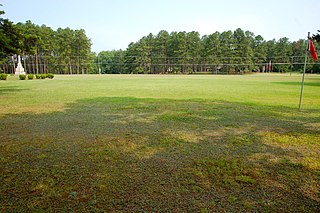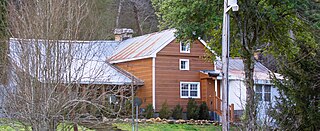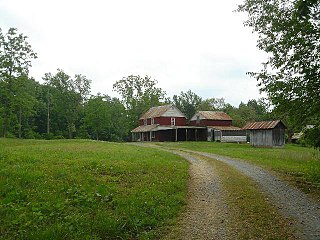
Horne Creek Farm is a historical farm near Pinnacle, Surry County, North Carolina. The farm is a North Carolina State Historic Site that belongs to the North Carolina Department of Natural and Cultural Resources, and it is operated to depict farm life in the northwest Piedmont area c. 1900. The historic site includes the late 19th century Hauser Farmhouse, which has been furnished to reflect the 1900-1910 era, along with other supporting structures. The farm raised animal breeds that were common in the early 20th century. The site also includes the Southern Heritage Apple Orchard, which preserves about 800 trees of about 400 heritage apple varieties. A visitor center includes exhibits, a gift shop and offices.

Stagville Plantation is located in Durham County, North Carolina. With buildings constructed from the late 18th century to the mid-19th century, Stagville was part of one of the largest plantation complexes in the American South. The entire complex was owned by the Bennehan, Mantack and Cameron families; it comprised roughly 30,000 acres (120 km2) and was home to almost 900 enslaved African Americans in 1860.

Alamance Battleground is a North Carolina State Historic Site commemorating the Battle of Alamance. The historic site is located south of Burlington, Alamance County, North Carolina in the United States.

This list includes properties and districts listed on the National Register of Historic Places in Wilkes County, North Carolina. Click the "Map of all coordinates" link to the right to view an online map of all properties and districts with latitude and longitude coordinates in the table below.

The Colonel Ira C. Copley Mansion, is a historic residence in Aurora, Illinois.

Latta Place, also known as Latta House, is a historic house located in Huntersville, North Carolina near Mountain Island Lake. Built in about 1800 in a Federal style, the plantation also contains some elements of Georgian design, including the house's main staircase.

The John Franklin Cobb House, also known as the Cobb Plantation, is a historic house in rural Cherokee County, North Carolina. The oldest portion of the house is a log structure built in 1863, making it one of the few surviving pre-Civil War structures in the county. It is also notable as a place frequented by baseball legend Ty Cobb in his childhood; he was a grandson of the original builder, John Franklin Cobb. The house is, outside of the log cabin at its core, a rambling structure consisting of a variety of additions to the original log cabin. The house has been enclosed in weatherboarding since the 1880s. It was for many years the center of a farm of some 150-200 acres, and was in the Cobb family until 1977.
James Monroe Thompson House, also known as Shady Rest, is a historic home located near Saxapahaw, Alamance County, North Carolina. The original one-story, single-pen, log house was built about 1850. In 1872, a two-story log addition was built, and the original building used as a kitchen. The log house is sheathed in weatherboard and sits on a stone foundation.

Jones–Jarvis House, also known as General Foster's Headquarters and Jarvis–Slover House, is a historic home located at New Bern, Craven County, North Carolina. It was built about 1810, and is a 2+1⁄2-story, three-bay, side-hall plan, Federal-style brick dwelling. It has a one-story brick and frame rear wing. During the American Civil War, General John G. Foster moved into this house, and it served first as his residence and later as part of the headquarters of the Eighteenth Army Corps.
Marcus Tilley House, also known as the Roscoe Tilley House, is a historic home located at Bahama, Durham County, North Carolina. It was built about 1880, and is a two-story, frame I-house built over an original 1+1⁄2-story log dwelling. Also on the property is a contributing log smokehouse.

Waller House, also known as the Waller-Joyner Farm, is a historic home located near Pfafftown, Forsyth County, North Carolina. The original 1 /2-story hewn log dwelling was built about 1770–1790, and later used as a kitchen. It is located adjacent to a 2-story hewn log dwelling built about 1800–1820. An open L-shaped porch was added in the 1940s connecting the two dwellings.

Hoskins House Historic District, also known as Tannenbaum Park, is a historic log cabin and national historic district located at Greensboro, Guilford County, North Carolina. The Hoskins House is a late-18th or early-19th century chestnut log dwelling house measuring 24 feet by 18 feet. It has an interior enclosed stair and exterior stone chimney. The house was restored in 1986–1987. Also on the property is the contributing Coble Barn. It is a large double-pen log barn of hewn V-notched logs under a long wood-shingled gable roof. The barn was moved to and restored at its current location in 1987. The Hoskins House site was the focal point of the British attack during the Battle of Guilford Court House on March 15, 1781. The Hoskins property survives today as an important satellite to the Guilford Courthouse National Military Park.
Ivy Burne, also known as the John Murchison Hodges, Sr. House, is a historic home and farm complex and national historic district located near Linden, Harnett County, North Carolina. It encompasses eight contributing buildings and one contributing site on a rural farm complex.

Singletary-Reese-Robinson House, also known as Woodlawn, is a historic home located at Laurel Park, Henderson County, North Carolina. It was built in 1912, and is a two-story, "L"-form, Rustic Revival style log dwelling. It has a two-story rear wing addition and features a hip-roof wraparound porch. Also on the property are the contributing spring (1912), barn (1912), and a 19th-century log spring house.

Lake Landing Historic District is a national historic district located near Lake Landing, North Carolina. The district encompasses 226 contributing buildings, 2 contributing sites, and 4 contributing structures related to agricultural complexes near Lake Landing. The district includes notable examples of Greek Revival, Queen Anne, and Coastal Cottage style architecture dating from about 1785 to the early-20th century. The Dr. William Sparrow octagon house, also known as Inkwell, is listed separately. Other notable buildings include the Fulford-Watson House, Gibbs Family House, Young-Roper-Jarvis House, Joseph Young House, Swindell-Mann-Clarke House, Amity Methodist Church, Chapel Hill Academy, St. George's Episcopal Church, John Edward Spencer Store, and George Israel Watson House (1896).
Henry Willis House, also known as Ehle House, is a historic home located near Penland, Mitchell County, North Carolina. It was built about 1880, and enlarged about 1890. It is a double-pen log house, with a weatherboarded log ell added after the turn of the 20th century. It was enlarged again about 1930 and in the 1980s. Also on the property is a contributing privy. It is one of the three traditional log homesteads in Mitchell County.
"River Daniel" Blue House, also known as Highlanders Farm, is a historic home located near Carthage, Moore County, North Carolina. It was built about 1795, and is a two-story, gable-roof log house sheathed in weatherboard. The house has two gable-end single, stepped-shoulder brick chimneys. Also on the property are the contributing "old kitchen," one-room log structure, and rail depot.
Paisley-Rice Log House is a historic home located near Mebane, Orange County, North Carolina. It believed to date to the late-18th century. The log dwelling is composed of two sections and follows the three-room Quaker plan, or Continental Plan. Located between the two sections is a chimney. The interior features vernacular Georgian woodwork.
Barber Farm, also known as Luckland, is a historic farm complex and national historic district located near Cleveland, Rowan County, North Carolina. The Jacob Barber House was built about 1855, and is a two-story, single-pile, three-bay vernacular Greek Revival style frame dwelling. It has a one-story rear ell and a one-story shed roofed rear porch. Its builder James Graham also built the Robert Knox House and the Hall Family House. Other contributing resources are the cow barn, smokehouse, granary, double crib log barn, well house, log corn crib / barn, carriage house, school, Edward W. Barber House (1870s), Edward W. Barber Well House (1870s), North Carolina Midland Railroad Right-of-Way, and the agricultural landscape.

George W. Logan House, also known as Jobe Hill, is a historic home located near Rutherfordton, Rutherford County, North Carolina. It built about 1842, and is a one-story, five-bay, Georgian plan frame dwelling. It is sheathed in weatherboard, has a side gable roof, and two rebuilt exterior end chimneys. It was enlarged and remodeled in the 1890s and in 1985. Also on the property are the contributing brick well house, dairy, outhouse, smokehouse, granary, log double corncrib, and a large log barn. It was the home of prominent North Carolina politician George Washington Logan (1815-1889).
















